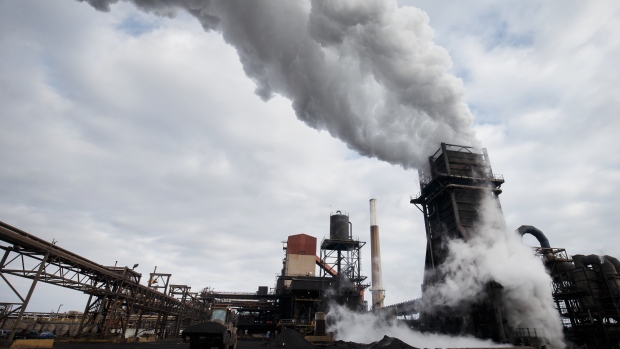Dec 31, 2019
Trudeau’s carbon tax set to take effect in industrial heartland
, Bloomberg News

Canadians are about to start paying a carbon tax in what is set to be a key political battleground of the 2019 election.
Beginning Jan. 1, Justin Trudeau’s government will start rolling out a “backstop” price on provinces that don’t have their own levies on emissions. That includes Ontario, an industrial heavyweight whose populist premier scrapped an existing plan, setting up a standoff with the Canadian prime minister.
Under Trudeau’s backstop, certain major industries in five provinces will see emissions tracked beginning Tuesday and subject to a yet-to-be-finalized tax; sectors such as cement and steel face easier targets than others. A wide-ranging tax on nearly all fuels is set to take effect in April in four provinces. The price on carbon will be $20 per metric ton -- about 4.4 Canadian cents per liter of gas, or 12 U.S. cents per gallon -- rising to $50 per ton by 2022.
Consumers in the holdout provinces will receive federal payments that will exceed their carbon tax bill in a bid to cushion the blow, according to government projections, as businesses essentially subsidize rebates to consumers. A court challenge is already underway, but the bigger fight may be political as voters will decide in October whether Trudeau deserves a second mandate.
“Carbon pricing will be an important issue as it connects to the economy -- and to Canadians who are increasingly worried about the economy,” pollster Nik Nanos of Nanos Research said.
Business Divided
Canadian business groups are divided in their response. The Business Council of Canada, representing chief executives of nearly all Canada’s biggest companies, backs Trudeau’s plan. “It provides the economic incentive for consumers to change their behavior and for businesses to invest in technologies that progressively reduce their emissions over time,” Goldy Hyder, the council’s president and CEO, said in a statement.
The Canadian Chamber of Commerce said it supports carbon pricing, but called on Trudeau to reduce the overall regulatory burden and return more revenues to businesses. The Canadian Federation of Independent Business, representing smaller firms, wants rebates to be expanded beyond just consumers.
Trudeau’s government is working to finalize industrial emissions standards, relative to current average emissions in each sector. It proposed a 95 percent standard for two industries considered at high competitive risk -- cement and lime, now facing more lenient standards than first proposed -- and 90 percent for production of petrochemicals, steel, certain types of iron, nitric acid and ammonia. All other sectors have a proposed 80 percent threshold. Companies exceeding those levels can pay a tax, or buy credits from more efficient firms.
‘Massive Exemption’
“Carbon pricing poses significant challenges for energy intensive, trade exposed sectors like cement, especially given our significant exports to US markets that don’t face similar costs,” the Cement Association of Canada, which represents producers such as LafargeHolcim Ltd.’s Canadian unit, said in a statement. That sector has essentially the highest exemption level under a plan it says will “will help reduce emissions, accelerate low carbon technology investments into Canada, while protecting local jobs.”
Conservative Leader Andrew Scheer, Trudeau’s main rival, has pledged to kill the carbon plan and replace it with one that doesn’t tax consumers. He hasn’t unveiled details but signaled it might shift more of the burden to big firms.
“I’m opposed to when the government increases the cost for commuters, for homeowners, people who have to heat their home,” Scheer told CTV’s Question Period in an interview this month, dismissing business groups who back the plan. “I’m not surprised that companies and CEOs of companies that have obtained a massive exemption from the carbon tax are now in favor of it.”
Paris Targets
Ontario Premier Doug Ford, a conservative elected in June, killed the province’s existing cap-and-trade program. Ontario is among provinces challenging Trudeau’s plan in court, and unveiled its own proposal in November, skipping what Ford calls “a job-killing carbon tax.”
Courts will substantially determine Ontario’s final climate plan -- a decision in Trudeau’s favor would almost surely shelve Ford’s version, and vice versa, though a final ruling could take years.
The industrial emissions plan applies to Ontario, New Brunswick, Manitoba, Prince Edward Island, and to electricity and natural gas pipelines in Saskatchewan. The fuel tax, to which the consumer rebates are tied, applies in Ontario, New Brunswick, Manitoba and Saskatchewan. Aside from Ontario, Canada’s other major provinces -- Quebec, British Columbia and Alberta -- all have existing, comparable climate plans, so the federal backstop won’t apply.
The plan, while controversial, still leaves Canada far short of its Paris Agreement target of 513 metric megatons of emissions by 2030. According to government figures published this month, Canadian emissions are projected to total 616 megatons by 2030 with “additional measures” like the backstop. They were about 704 megatons as of 2016, the figures show.
“The federal backstop will apply because pollution knows no borders,” Trudeau’s Environment Minister, Catherine McKenna, told reporters in Ottawa this month. “We know that it can no longer be free to pollute anywhere.”


